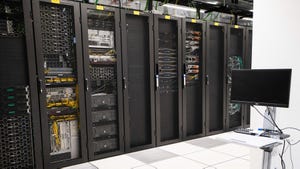Heat Reuse Strategies for Liquid-Cooled Data CentersHeat Reuse Strategies for Liquid-Cooled Data Centers
Liquid cooling not only cuts energy use in data centers but also unlocks heat reuse opportunities – benefiting operators and local communities alike.

If you follow news about data center sustainability trends, you may know that liquid cooling is one innovative way to reduce the amount of electricity consumed by data centers.
But did you also know liquid cooling could help data centers engage surrounding communities in positive ways, too? Read on for a look at how liquid cooling systems could enable heat reuse strategies that benefit not just data center operators, but also their neighbors.
What is Liquid Cooling?
In data centers, liquid cooling is a technique that dissipates heat using water or other liquid.
Liquid cooling is more expensive than conventional data center cooling methods, which cool down equipment by blowing air over it. But liquid cooling has grown in popularity in recent years because it can significantly reduce data center energy use. This is primarily due to the ability of liquids to transfer heat much more efficiently than air thanks to higher rates of heat transfer.
In addition, some liquid cooling systems – specifically, those that use direct-to-chip cooling techniques – can target the specific IT components that generate the most heat. This increases the efficiency of liquid cooling further because unlike air cooling systems, liquid cooling doesn’t waste energy blowing the cooling medium around components that don't need to be cooled.

Nordic data center operator atNorth has been recycling excess heat for use across various applications, including food production and housing (Image: atNorth)
Reusing Heat From Liquid Cooling Systems
Typically, the focus of engineers who design liquid cooling systems is on transferring heat from IT equipment to liquid, then moving the liquid away. What happens after the heat is dissipated is often not their concern. As a result, many liquid cooling systems discharge heated water into drainage systems, where the heat is wasted at best and, at worst, contributes to thermal pollution.
But it doesn't have to be this way. Instead of wasting the heat absorbed by liquid cooling systems, data centers can reuse it in creative ways.
For example, consider the following heat reuse scenarios.
1. Transferring heat to neighboring communities
One possibility is moving water that is heated inside data centers to the surrounding community and using it to heat buildings. By connecting liquid cooling systems to hydronic heating systems in homes and offices, data centers can effectively double down on the sustainability benefits of liquid cooling. Not only would it cool down IT equipment more efficiently, but it would also reduce the amount of energy that local communities would use for heat.
On top of this, a heat reuse strategy along these lines could help data centers improve relations with local residents – which is important because those relations are not always peachy. If data center operators offered heat to local communities for free or at a low cost, it would likely be easier for locals to feel more warmly toward data centers.
2. Reusing heat within the data center
A variant on the preceding data center heat reuse strategy is to circulate heated liquid within the data center itself and use it to warm spaces occupied by personnel. The value of this approach would likely be limited because most data centers don't have a large amount of office space to heat, and server rooms tend to be warm on their own because of the ambient heat produced by IT equipment. Still, this would be better than letting heat wash down the drain.
3. Letting water cool naturally
A third possible strategy is to let heated water lose its heat naturally by storing it in a reservoir and allowing it to cool down on its own. This approach would not reuse the heat, per se, but it would prevent thermal pollution in local bodies of water by preventing the influx of hot water into them.
In addition, this option would make it feasible to reuse the same water for liquid cooling as part of a closed-loop system, as opposed to having to ingest fresh water into the system constantly. In turn, it would improve the system's water use efficiency and reduce the pressure that data centers place on local aquifers.
Turning Waste
Liquid cooling is virtually always more energy-efficient than air cooling. But by creatively reusing heat, data center operators can make liquid cooling even more attractive from a sustainability perspective, while also potentially enhancing relations with local communities to boot.
About the Author
You May Also Like









